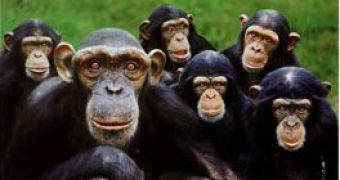This is our closest relative, and like us, chimps are assigned to ... races!
The most complex research to date on the chimp genetics has revealed that the traditional, geography-based classification of the chimps into three populations (western, central and eastern) is highly supported by strong genetic differences, two to three times bigger than found between the human races.
The mix team from the University of Chicago, Harvard, the Broad Institute and Arizona State found a weak mixture between the distinct populations and chimpanzees from the central and eastern populations, which display a lower genetic difference than with that of the western "subspecies." The team made a simple set of 30 DNA markers that can track down the unknown origins of a chimpanzee.
"Finding such a marked difference between the three groups has important implications for conservation. It means we have to protect three separate habitats, all threatened, instead of just one." said senior author Dr. Molly Przeworski, assistant professor of human genetics at the University of Chicago.
The team examined DNA from 78 common chimpanzees and 6 bonobos (a distinct chimp species) for 310 DNA markers. The results revealed the existence of four "discontinuous populations", three of common chimps (Pan troglodytes) and one of bonobo (Pan paniscus).
Most of the hybrids (individuals with over 5 % of their DNA from more than one common chimpanzee population) were captivity born.
"We saw little evidence of migration between groups in the wild," said first author Celine Becquet, a graduate student in Przeworski's laboratory. "Part of that could stem from the gaps in our samples, but we think most of this separation is genuine, a long-term consequence of geographic isolation."
Rivers are the most effective barrier between chimp populations. "Chimps don't swim. For them, water provides a very effective border." said Bequet. Congo River, a 1.5 million years old water flow, isolated bonobo on the south from the other chimps.
Forest fragmentation could have raised the separation level between the three groups.
The DNA difference made the researchers estimate that bonobos split off from the main ancestral common population about 800,000 years ago. Western chimps could have separated roughly 500,000 years ago and the split off between the central and eastern chimps emerged 250,000 years ago.
"Even though the chimp genome has been sequenced, it's amazing how little we know about their evolution and the level of variation within chimpanzees," said Przeworski. "These are our nearest relatives, closer to humans than they are to gorillas, yet we know so little about them, and even less about gorillas and orangutans."
The bonobo and chimpanzee genomes present just a 0.3 % difference, 25 % of the value between the humans and chimps, but this little value translates by hugely divergent social systems, cultures, diets and mating systems.
Oppositely, between the three "subspecies" of common chimpanzees, "we found significant genetic variation, but there's very little detectable difference between the populations in terms of appearance or behavior." said Przeworski,

 14 DAY TRIAL //
14 DAY TRIAL //